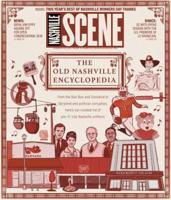
It’s impossible to look back at the history of the Nashville Scene without paying tribute to the man who helped define the publication perhaps more than anyone else. Jim Ridley, who worked at the paper for a quarter-century and served as its chief editor for the better part of a decade, was a singular writer, a peerless film critic, an inexhaustible champion of the arts and a mentor to dozens of local journalists.
As an editor, Ridley was a wizard. Former editor-in-chief Steve Cavendish remembers this: “I was a thousand words into explaining a complex piece of tobacco litigation for a Scene cover story, and what I turned in was, well, not great. Jim not only untangled it, he added this little gem: ‘The ash hadn’t hit the tray before the tobacco companies appealed.’ It makes me smile every time.”
Former Scene staffer Steve Haruch compiled Ridley’s film writing into a collection published by Vanderbilt University Press last year. People Only Die of Love in Movies is a compendium of nearly 100 film reviews and features penned by Ridley for the Scene and other publications.
“There are literally thousands of great things that Jim created for the Scene that never appeared under his name,” says Cavendish, “from 150-word Critic’s Picks to whole sections of stories that needed to be rewritten. So, yeah, the world lost a powerful critic, but every Scenester lost the best editor a writer could dream of having.”
For our 30th anniversary issue, we asked staffers and contributors past and present to share their favorite of Jim’s enduring works. The stories span the era from the early ’90s to one month before his death in 2016. Rollicking concert reviews, a history of queer life in Nashville, a deep dive into roadside comfort food and more, Ridley’s colleagues cover enough ground to keep you busy all week.
Deep Focus — Aug. 4, 1994
“For students, Prof. Brooks made French culture attractive through sheer force of personality: When he greeted students ‘Bonjour!,’ he did so not with an instructor’s reserve but with a boulevardier’s gusto.”
My dear friend Franklin Brooks died on July 25, 1994. Jim had taken a French course from him while he was at Vanderbilt. He captured Franklin’s essence with the lightest, sweetest touch. Jim had that gift, not just for cleverness, but for caring too. He could be elegant at every word. — John Bridges, Scene staff, 1989-1998
Last Call at Juanita’s: The untold story of Nashville’s oldest gay bar — Oct. 19, 1995
“They recall Miss Juanita in 1953, a strong, husky woman striding down the sidewalk in front of the old Sam Davis Hotel toward Commerce Street. Her fiery red hair gave her the look of a lighted powder keg. In 1953 she had just taken over the tiny lounge that bore her name.”
It really showcases Jim’s ability to tell you about something you know nothing about in a way that makes you immediately feel invested in it and protective of it and in love with it. — Betsy Phillips, contributor, 2008-2018
The Play’s the Thing: Kenneth Branagh’s dynamic Hamlet — Feb. 20, 1997“
"In Hamlet’s paradoxical world, fiction has the power to unmask, to conceal, or even to kill; to act means either to make a decisive move or to hide one’s grisly deeds and intentions — sometimes both at once.”
Only Jim Ridley could turn a simple film review into a graduate seminar on Jacobean dramaturgy, Shakespearean wordplay and the art of adaptation — and all in language worthy of the Bard himself. — Margaret Renkl, contributor, 1996-2009
Night Spot: The mysterious, mundane magic of Waffle House — Aug. 7, 1997
“To translate Winston Churchill’s famous description of Russia into wafflecentric terms, the Waffle House is a mystery smothered, covered, chunked, and topped with an enigma.”
It’s no wonder this story has been taught in feature-writing classes; it’s a perfect mix of observation, obsessive fact-hoarding and personal narrative that somehow makes a story about a so-ubiquitous-as-to-be-nearly-invisible roadside chain restaurant, best known for its waffles and hash browns, into a story about comfort and human longing. — Steve Haruch, Scene staff, 2007-2014
A Dog’s Life: The times of Lucy’s Record Shop — Jan. 29, 1998
“On a rainy Friday night in front of the venue, on the crowded sidewalk that has served as the city’s informal meeting place for teen punk fans, dozens of kids jostled, pantomimed, and ground cigarettes beneath their sneakers into the cold, wet concrete. But a strange uncertainty was felt, in the whispers and the too casual conversations on the pavement.”
More than a time capsule of Nashville during the 1990s, Jim’s tribute to Lucy’s Record Shop is an evocative rumination on the ephemerality of local scenes, underground movements and independently owned businesses, while at the same time affirming their enduring, transformational power. — Jonathan Marx, Scene staff, 1990-2006
Fade to Black: Can the Watkins Belcourt be saved? — Jan. 21, 1999
“If dull familiarity is what Nashvillians want, they’ll be amply rewarded — either by Patch Adams on three screens at every megaplex, or by the umpteenth production of Smoke on the Mountain at the local playhouse. If these represent the pinnacle of our intellectual curiosity, it’s a sad joke that we’re investing in a $15 million downtown arts center. What will we enshrine there? Paintings of kittens and sunsets?”
I can’t think of a story that better demonstrates the power of journalism to shape the future of a city than ‘Fade to Black,’ Jim’s impassioned call to arms to save our city’s arthouse theater, the Belcourt, from imminent demise. The gleaming new Belcourt quite likely wouldn’t exist without that 1999 cover story and Jim’s countless pieces drawing attention to his beloved local cinema sanctuary. — Jack Silverman, Scene staff and contributor, 1997-present
The Year in Review: Scene writers survey highlights (and some lowlights) in music, books, arts and culture — Dec. 18, 2003
“Sunset, approx. 4:35 p.m. Nov. 18. Not just any sunset, mind you — a savage Van Gogh stippling of storm clouds and sunlight that streaked the sky with fire and bruises. Through the plate-glass window of a 100 Oaks superstore, it looked like an advancing tidal wave of flame — a reckoning. Outside, shoppers stood stopped in their tracks, wide-eyed and open-mouthed, as reflecting puddles on the asphalt smoldered like magma. When I tried to call people to tell them to look, the phones were down. Sometimes nature sends us a message if it thinks we aren’t paying attention. Such a sky does not happen by accident. I still wonder what it means.”
Tucked away in an 11,000-word roundup of Scene staffers’ favorite 2003 discoveries is Jim Ridley’s No. 1, a brief but gobsmacking blurb about an autumn sunset — an awe-inspired and awe-inspiring recollection about the kind of moment most of us would overlook, rendered in impossibly tender prose. — D. Patrick Rodgers, Scene staff (2008-present) and current editor-in-chief
Missed Opportunities: Kick yourself for not seeing these movies — Dec. 27, 2007
“Chris Sivertson’s mystifying mood piece [I Know Who Killed Me] about a demure honor student who morphs into a mutilated stripper was sold as torture porn, but it’s closer in spirit to a glue-huffing remake of Kieslowski’s The Double Life of Veronique.”
Satoshi Kon, Lake of Fire and I Know Who Killed Me playing nice with Tsai Ming-Liang, Edward Burtynsky, local interest features and artsy kindertrauma. Nobody did it better, or with a more expansive heart, than Jim. I am no expert on the ways of the universe; I am not having new conversations with whatever is beyond. But I am continuing one that started 20-odd years ago. — Jason Shawhan, contributor, 2000-present
The Spin: The Raconteurs at the Cannery — Apr. 15, 2008
“From the grinding opening groove of ‘Consoler of the Lonely,’ every hook-loaded, arm-windmilling song sounds as though the sun had melted a whole stack of Who, Badfinger, Thin Lizzy and Boston LPs into a foot-thick brick of Super Seventies goodness.”
Jim’s 2008 review of the Raconteurs show at the Cannery stands as the TL;DR of how to write: The band comes out “swinging their dicks like Louisville sluggers,” looking like Bob Dylan’s Basement Tapes meets Slap Shot. Plus, “every hook-loaded, arm-windmilling song sounds as though the sun had melted a whole stack of Who, Badfinger, Thin Lizzy and Boston LPs into a foot-thick brick of Super Seventies goodness.” Take notes, kids. — Tracy Moore, Scene staff, 2005-2011
Bruce Springsteen and the E Street Band at Bridgestone Arena — Apr. 18, 2014
“Time throws you off a rooftop the day you’re born, and the fall you have to the pavement is called a life. The Springsteens of the world are there to remind us the object is to never stop kicking and punching and straining for the sky, all the way to the inevitable finish.”
Jim transcended the medium, turning a concert review into a sage rumination on life, and all the joy, sadness, hope, despair and turns of phrase that come with it — kind of like a great Springsteen song. — Adam Gold, Scene staff, 2008-2017
The Umbrellas of Cherbourg: A Finite Forever — July 23, 2014 for The Criterion Collection
“More than any other film I know, Umbrellas affects people differently at different stages of life. When I first saw it, newly married but still remembering vividly the pang of adolescent crushes, it played as tragedy: the story of a young love snuffed out by war, fate, and economic hardship. Over the years, seen in the light of Demy’s other films, it has come to seem more properly an exaltation of life’s bittersweet balances and trade-offs — of unexpected triumphs made richer by the dashed hopes that offset them.”
It’s rare that a film review can make you cry as much as the actual film does, but Jim’s tender description of the delirium of first love — and the grim realities of real life — hit you right in the gut. He also seamlessly weaves Western capitalism, James Joyce and The Shirelles into his review. Who does that? Jim Ridley, that’s who. — Abby White, Scene staff, 2012-2015
Best Nighttime Fun: John Seigenthaler Pedestrian Bridge, Best of Nashville 2014
“It’s free, and the rewards are immense. The skyline’s a jewelbox, the view breathtaking, the mood festive; the Cumberland shimmers with pools of reflected color, periodically rippled by a barge or passing steamboat. (Go in the daytime, and it doubles as a chance to check out the fountain park and climbing wall at nearby Cumberland Park.) It makes your heart swell. Stand on one of the overlooks with your wide-eyed kids, and tell them: This is where you live. This is your city.”
I keep coming back to Jim’s gemlike salute to the Seigenthaler Pedestrian Bridge — a few sentences into which he packs a practical tip for parents, a poetic appreciation of a piece of infrastructure and a note of civic pride. — Stephen Trageser, Scene staff, 2014-present
I Saw the Light travels Hank Williams’ lost highway to its bitter end — Mar. 24, 2016
“Over the years, Williams, like many an artist who did his legend the favor of dying young, has been embraced as an emblem of many things: artistry stoked by suffering, rebel-yell belligerence, misunderstood genius, the honky-tonk cult of true experience.”
One of the last pieces Jim ever wrote was about the Nashville premiere of the Hank Williams biopic I Saw the Light, and even though the film itself isn’t that great, Jim used some of his space at the top of the article to pen one of the most evocative and accurate descriptions I ever read of Williams’ music, and how it makes its own movies in the listener’s mind. — Noel Murray, Scene staff, 1993-1995; contributor, 1996-present





